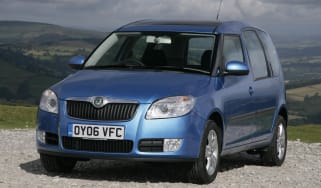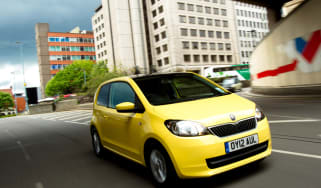Skoda Roomster MPV (2006-2015)
"While it’s no longer on sale, the Skoda Roomster remains a practical and economical car for growing families."
Pros
- Spacious and flexible interior
- Cheap to buy and run
- Quirky and individual
Cons
- Uninspiring interior
- Basic model is short on kit
- Diesels can be noisy
The Skoda Roomster was Skoda's unconventional approach to the small MPV. It never offered seven seats, but its interior was still immensely practical thanks to rear seats that could fold and tumble or be completely removed for carrying large items. The Roomster's strength was its ability to provide a practical interior in a model that was more like a small car to drive than rivals such as the Citroen C4 Picasso.
Roomster production has now officially finished, so while it’s no longer possible to order a new one, there are plenty of year-old Roomsters out there. If you’re happy with not being able to specify the car to your exact taste, it’s possible pick up an approved used Roomster from a Skoda dealer.
A good range of engines was offered with the Roomster, although all models focused on economy rather than performance. The economical diesels continue to make a lot of sense, but even the small 1.2-litre petrol should be cheap to run, even if it’s also very slow.
Roomster S was the most basic trim level and included electric windows, a 12v socket and central locking, although air-conditioning didn’t feature. You needed to go for SE trim for that, and that model also included a panoramic sunroof, which made the interior seem much more airy. The Roomster Scout model had roof rails and plastic protection for the car's bodywork.
MPG, running costs & CO2
The cheapest model of Roomster to run is the 1.2-litre diesel GreenLine II, which can see up to 67.3mpg and emits just 109g/km of CO2 for road tax of £20 a year. The hi-tech 1.2-litre petrol is also cheap to run, however – it can return just under 50mpg and emits 134g/km of CO2. The basic 1.2-litre petrol was the cheapest model to buy, but it remains the least efficient, returning 45.6mpg and emitting 143g/km of CO2.
Insurance for all Roomsters should be relatively cheap and Skoda offers fixed-price services that start from just £139.
Engines, drive & performance
One engine worth avoiding in the Skoda Roomster is the basic 1.2-litre petrol. It has just 69bhp and feels underpowered almost all the time. The more powerful 1.2-petrol makes much more sense. It came with 104bhp, which knocked nearly five seconds off the car’s 0-62mph time to complete the benchmark sprint in 10.9 seconds. We’d still recommend the 90bhp 1.6-litre diesel, however, as it has more mid-range power than the petrol, so it’s better for overtaking and is also a lot cheaper to run.
The Skoda Roomster was based on the Skoda Fabia, so it’s actually better to drive than you might imagine. There’s plenty of grip in the corners and the steering is accurate, but a tall body means there’s also quite a lot of body lean.
Interior & comfort
While the diesel Roomsters offered excellent fuel economy, they could be quite noisy, so the hi-tech petrol is a much better option in that regard. The Skoda Roomster shared many of its parts with Volkswagen models, so it always felt well built inside. As is to be expected with a car that’s no longer in production, the Roomster feels dated and doesn’t have the same classy touches as more modern Skodas.
One thing hasn’t changed, though, is that the Roomster continues to offer excellent comfort, thanks to having lots of head and legroom, while its suspension does a good job of soaking up bumps. All models do a decent job of keeping wind and road noise at bay, too.
Practicality & boot space
Practicality is what the Skoda Roomster was all about and it was one of the most spacious cars available for the price. Even with the rear seats up, you got 450 litres of boot space, which was much more than the 380 litres a Volkswagen Golf offered. The back seats could also slide forwards and backwards and the outer two seats reclined, too.
Meanwhile, the car’s VarioFlex seating system is simple to operate, so it’s easy to fold down the back seats. Doing so gives the Roomster a maximum load capacity of 1,780 litres. And, if that’s not enough, the Roomster’s seats can be completely removed.
There were always plenty of storage spaces in the Roomster, with two gloveboxes, wide door pockets and the option of fitting under-seat storage, as well.
Reliability & safety
The Skoda Roomster came 62nd out of 200 cars in our 2015 Driver Power customer satisfaction – an improvement on its 81st place finish in the 2014 poll. The car still scored well for practicality, reliability and its ease of driving, although Roomster owners felt their cars lagged behind in terms of in-car technology and build quality wasn’t felt to be a strong suit.
Skoda’s third-place finish overall (out of 32 manufacturers) was more encouraging, so if you buy a year-old Roomster from a franchised dealer, you should be well looked-after.
A five-star crash safety rating from Euro NCAP also counted in the Skoda’s favour and all models came with six airbags, anti-lock brakes and ISOFIX child-seat mounting points. Electronic stability control was only an option on the basic model, however.
Price, value for money & options
With such an attractive purchase price, buyers didn’t expect the Skoda Roomster to come with lots of equipment and the basic model did without things such as air-conditioning, although it did get electric front windows, a CD player and a 12v power socket. Roomster buyers who went for an SE model got more equipment: air-conditioning, an alarm and electric mirrors were all included here. The Roomster Scout had more rugged looks thanks to plastic protection for the car’s body, and the inclusion of roof rails.
Being owned by the Volkswagen Group has done Skoda wonders when it comes to used values. While the company’s cars tend hold their value better than similar models from Citroen, Fiat and Ford, a secondhand Roomster is an attractive proposition considering the amount of space you get for your money.













